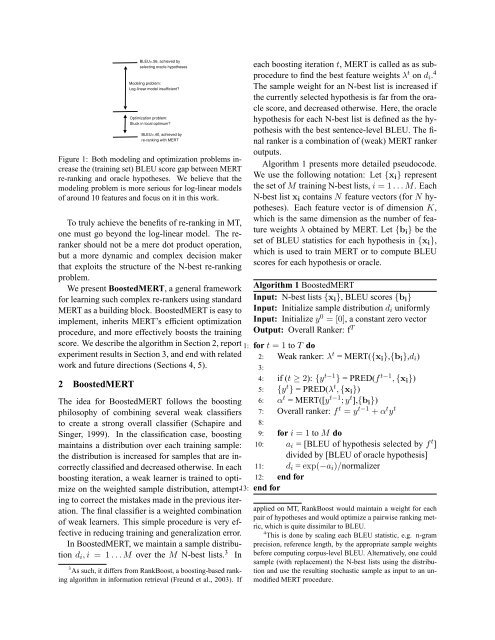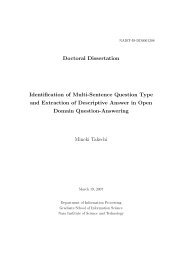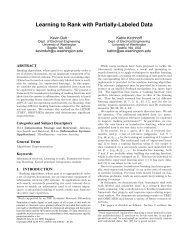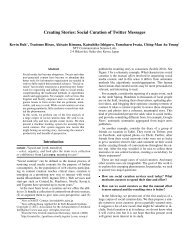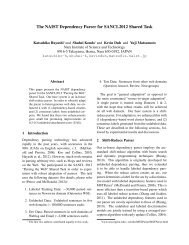Boosted Minimum Error Rate Training for N-best Re-ranking
Boosted Minimum Error Rate Training for N-best Re-ranking
Boosted Minimum Error Rate Training for N-best Re-ranking
Create successful ePaper yourself
Turn your PDF publications into a flip-book with our unique Google optimized e-Paper software.
BLEU=.56, achieved by<br />
selecting oracle hypotheses<br />
Modeling problem:<br />
Log-linear model insufficient?<br />
Optimization problem:<br />
Stuck in local optimum?<br />
BLEU=.40, achieved by<br />
re-<strong>ranking</strong> with MERT<br />
Figure 1: Both modeling and optimization problems increase<br />
the (training set) BLEU score gap between MERT<br />
re-<strong>ranking</strong> and oracle hypotheses. We believe that the<br />
modeling problem is more serious <strong>for</strong> log-linear models<br />
of around 10 features and focus on it in this work.<br />
To truly achieve the benefits of re-<strong>ranking</strong> in MT,<br />
one must go beyond the log-linear model. The reranker<br />
should not be a mere dot product operation,<br />
but a more dynamic and complex decision maker<br />
that exploits the structure of the N-<strong>best</strong> re-<strong>ranking</strong><br />
problem.<br />
We present <strong>Boosted</strong>MERT, a general framework<br />
<strong>for</strong> learning such complex re-rankers using standard<br />
MERT as a building block. <strong>Boosted</strong>MERT is easy to<br />
implement, inherits MERT’s efficient optimization<br />
procedure, and more effectively boosts the training<br />
score. We describe the algorithm in Section 2, report<br />
experiment results in Section 3, and end with related<br />
work and future directions (Sections 4, 5).<br />
2 <strong>Boosted</strong>MERT<br />
The idea <strong>for</strong> <strong>Boosted</strong>MERT follows the boosting<br />
philosophy of combining several weak classifiers<br />
to create a strong overall classifier (Schapire and<br />
Singer, 1999). In the classification case, boosting<br />
maintains a distribution over each training sample:<br />
the distribution is increased <strong>for</strong> samples that are incorrectly<br />
classified and decreased otherwise. In each<br />
boosting iteration, a weak learner is trained to optimize<br />
on the weighted sample distribution, attempting<br />
to correct the mistakes made in the previous iteration.<br />
The final classifier is a weighted combination<br />
of weak learners. This simple procedure is very effective<br />
in reducing training and generalization error.<br />
In <strong>Boosted</strong>MERT, we maintain a sample distribution<br />
d i , i = 1 . . . M over the M N-<strong>best</strong> lists. 3 In<br />
3 As such, it differs from RankBoost, a boosting-based <strong>ranking</strong><br />
algorithm in in<strong>for</strong>mation retrieval (Freund et al., 2003). If<br />
each boosting iteration t, MERT is called as as subprocedure<br />
to find the <strong>best</strong> feature weights λ t on d i . 4<br />
The sample weight <strong>for</strong> an N-<strong>best</strong> list is increased if<br />
the currently selected hypothesis is far from the oracle<br />
score, and decreased otherwise. Here, the oracle<br />
hypothesis <strong>for</strong> each N-<strong>best</strong> list is defined as the hypothesis<br />
with the <strong>best</strong> sentence-level BLEU. The final<br />
ranker is a combination of (weak) MERT ranker<br />
outputs.<br />
Algorithm 1 presents more detailed pseudocode.<br />
We use the following notation: Let {x i } represent<br />
the set of M training N-<strong>best</strong> lists, i = 1 . . . M. Each<br />
N-<strong>best</strong> list x i contains N feature vectors (<strong>for</strong> N hypotheses).<br />
Each feature vector is of dimension K,<br />
which is the same dimension as the number of feature<br />
weights λ obtained by MERT. Let {b i } be the<br />
set of BLEU statistics <strong>for</strong> each hypothesis in {x i },<br />
which is used to train MERT or to compute BLEU<br />
scores <strong>for</strong> each hypothesis or oracle.<br />
Algorithm 1 <strong>Boosted</strong>MERT<br />
Input: N-<strong>best</strong> lists {x i }, BLEU scores {b i }<br />
Input: Initialize sample distribution d i uni<strong>for</strong>mly<br />
Input: Initialize y 0 = [0], a constant zero vector<br />
Output: Overall Ranker: f T<br />
1: <strong>for</strong> t = 1 to T do<br />
2: Weak ranker: λ t = MERT({x i },{b i },d i )<br />
3:<br />
4: if (t ≥ 2): {y t−1 } = PRED(f t−1 , {x i })<br />
5: {y t } = PRED(λ t , {x i })<br />
6: α t = MERT([y t−1 ; y t ],{b i })<br />
7: Overall ranker: f t = y t−1 + α t y t<br />
8:<br />
9: <strong>for</strong> i = 1 to M do<br />
10: a i = [BLEU of hypothesis selected by f t ]<br />
divided by [BLEU of oracle hypothesis]<br />
11: d i = exp(−a i )/normalizer<br />
12: end <strong>for</strong><br />
13: end <strong>for</strong><br />
applied on MT, RankBoost would maintain a weight <strong>for</strong> each<br />
pair of hypotheses and would optimize a pairwise <strong>ranking</strong> metric,<br />
which is quite dissimilar to BLEU.<br />
4 This is done by scaling each BLEU statistic, e.g. n-gram<br />
precision, reference length, by the appropriate sample weights<br />
be<strong>for</strong>e computing corpus-level BLEU. Alternatively, one could<br />
sample (with replacement) the N-<strong>best</strong> lists using the distribution<br />
and use the resulting stochastic sample as input to an unmodified<br />
MERT procedure.


